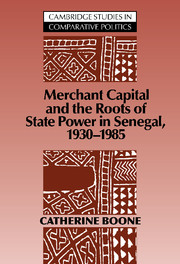Book contents
- Frontmatter
- Contents
- List of tables and figure
- Preface and acknowledgments
- Introduction
- 1 Capital and contingencies of postcolonial politics
- 2 The colonial market
- 3 Consolidation of a regime: Neocolonialism in the 1960s
- 4 Growth of Senegal's textile industry, 1960–1975
- 5 Reappropriation of the state: The 1970s
- 6 Demise of the Dakar textile industry
- Conclusion: States, capital, and capitalist states
- Appendix: Exchange rates
- References
- Index
6 - Demise of the Dakar textile industry
Published online by Cambridge University Press: 13 October 2009
- Frontmatter
- Contents
- List of tables and figure
- Preface and acknowledgments
- Introduction
- 1 Capital and contingencies of postcolonial politics
- 2 The colonial market
- 3 Consolidation of a regime: Neocolonialism in the 1960s
- 4 Growth of Senegal's textile industry, 1960–1975
- 5 Reappropriation of the state: The 1970s
- 6 Demise of the Dakar textile industry
- Conclusion: States, capital, and capitalist states
- Appendix: Exchange rates
- References
- Index
Summary
State authorities face a political choice between certain Senegalese commercial interests and the local textile industry.
“Interview with M. Paul Warnier, director of Icotaf,” Africa, no. 103, août–septembre 1978The truth of the matter is that the French industrialists in the textile industry, greedy for super profits, refuse to leave any space in this business for Senegalese in order to preserve their monopoly power and to force the government to subsidize profits which they repatriate to Europe. … In whose name, and on the basis of what justification, should we sacrifice [the Senegalese-controlled textile trade] for the benefit of les industriels français du textile?
“Textile: Halte aux manoeuvres contre les hommes d'affaires sénégalais,” Taxaw, no. 12, août 1978President Senghor, in a March 1970 speech in Paris, cited the rising index of industrial production to show that the Senegalese textile industry was in pleinessor (full takeoff). Employment, production, and local value-added were on the rise, making the textile industry Senegal's “most dynamic sector in importsubstitution” (World Bank 1974:222). The drought of 1973 affected the entire Senegalese economy, but the general view at the time was that the industrial sector would recover from this setback. High rates of tariff protection gave textile producers a priori claim to a share of the domestic market in goods times and in bad.
- Type
- Chapter
- Information
- Merchant Capital and the Roots of State Power in Senegal1930–1985, pp. 207 - 251Publisher: Cambridge University PressPrint publication year: 1992



